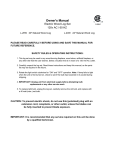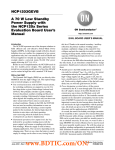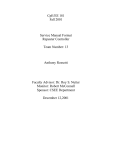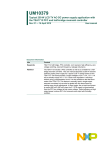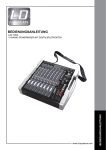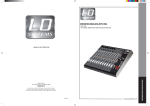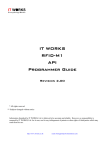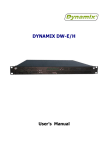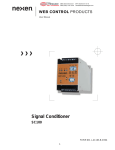Download GlimpseCatcher User Manual 1.00
Transcript
GlimpseCatcher User Manual 1.00 GlimpseCatcher User Manual 1.00 CATCH THE GLIMPSE !!! Email: [email protected] 1/16 GlimpseCatcher User Manual 1.00 Table of contents Introduction............................................................................................................................3 Scope of supply ......................................................................................................................3 Disclaimer ..............................................................................................................................3 Main features..........................................................................................................................4 Installation..............................................................................................................................6 Description .............................................................................................................................6 Operation ...............................................................................................................................9 Operation of the timing control process ..............................................................................9 Operation of the configuration ..........................................................................................10 Closing words.......................................................................................................................14 Annex (photos).....................................................................................................................15 Email: [email protected] 2/16 GlimpseCatcher User Manual 1.00 Introduction The GlimpseCatcher is a configurable control unit for time-controlled processes in the range from microseconds to half an hour for each individual time phase. It was developed as a purely private hobby-project for photographic applications in the field of “high-speed photography”, i.e. with regard to drop photography. Besides drop photography it may of course be used for every other type of “high-speed photography”, like for example ballistic photos, … In addition, it may be used for time-lapse photography or other time-controlled processes. Scope of supply The scope of supply consists of following elements: Fully assembled GlimpseCatcher incl. Arduino Uno (mail delivery) GlimpseCatcher Arduino-Code, readily installed on Arduino Uno, without source code (mail delivery) GlimpseCatcher GUI in language as selected, for Windows, without source code (email delivery) Present user manual (email delivery) The necessary Arduino-drivers and the Microsoft .NET frameworks (if not installed anyway yet) may be downloaded for free from the Internet: Arduino: Microsoft: http://arduino.cc/en/Main/Software http://msdn.microsoft.com/en-us/netframework Note: It is not necessary to install the complete Arduino software. The actual driver only is sufficient. Disclaimer The GlimpseCatcher is a purely private hobby-project and no commercial product for the mass market. On request at [email protected] it can be offered and produced in individual units and in very restricted quantities. Each individual unit is carefully checked and tested to the best of the developer’s knowledge and belief. A guarantee, a warranty or a responsibility for the use or the functionality can not be given or taken over by the developer. The same applies to the present user manual. All liability for potential damages or other consequences, which may be the result of the use of the GlimpseCatcher is excluded, may they be of material, health-related or any other type. Also, no obligations of the developer are included with regard to future developments, adaptations or support in general. Email: [email protected] 3/16 GlimpseCatcher User Manual 1.00 Main features The main features of the GlimpseCatcher are as follows: Control of up to 6 devices in parallel (i.e. solenoid valves) with up to 10 phases per device (i.e. 5 drops per solenoid valve). The control may be individually configured per device, either in timely relation towards the start of the process or towards one of 2 external triggers, which will be triggered during the course of the process. The corresponding intervals are defined in microseconds (precision see further down). Control of any combination of up to 6 cameras and/or flashes in parallel (i.e. several parallel flashes for a specific lighting setup, several flashes in sequence for stroboscopic captures, two cameras for stereo photos with any combination of up to 4 parallel/sequential flashes, …). The control may be individually configured per camera/flash, either in timely relation towards the start of the process or towards one of 2 external triggers, which will be triggered during the course of the process. The corresponding intervals are defined in microseconds (precision see further down). Two external trigger circuits which react each on the first appearing edge, either rising or falling (i.e. closing of the open trigger circuit by shortly connecting 2 bare wire ends via a falling drop, opening of the closed trigger circuit by shooting through a thin wire/tinsel filament in front of the muzzle of an airgun, closing of the open trigger circuit by impact onto a contact switch, …) Automated repeatability of the process (up to 5.000 times) for the realization of „videos“ or for the determination of the best suited timings for a particular scenario. For each individual phase of each individual device, camera or flash an increment may be defined, by which the corresponding phase will be incremented at each repetition of the process. In addition a constant waiting time in between repetitions may be defined (i.e. in order to let the water surface calm again between several drop occurrences). Optimized algorithm for the control of devices, cameras and flashes in order to allow highest possible precision. All timing specifications are done in microseconds. The minimum time for an executable phase is 500 microseconds* (increments may be smaller). The maximum time for an executable phase is half an hour (1.800.000.000 microseconds). The precision depends on the number of actually used devices, cameras and flashes and is the higher the less equipment is used. The cycle time of a minimal configuration (1 device, 1 camera, 1 flash) is approx. 250 microseconds according to tests, meaning that the average variation towards the specified values would be approx. 125 microseconds (approx. 1/8 millisecond). The cycle time of an absolute maximal configuration (6 devices, 6 cameras/flashes) is approx. 460 microseconds according to tests, meaning that the average variation towards the specified values would be approx. 230 microseconds (approx. 1/4 millisecond). After each complete process execution the maximum cycle time of this process execution is displayed. * Regarding the minimum it must be taken into account what is reasonably feasible for the particular connected equipment. Some solenoid valves for example do not operate Email: [email protected] 4/16 GlimpseCatcher User Manual 1.00 reliably anymore with timings below 20 milliseconds. Other equipment (flashes, …) may allow considerably lower timings. Simple and clear configuration of the GlimpseCatcher on the PC. Configured values will be maintained even if the GlimpseCatcher is temporarily switched off. Complete configurations may be saved on the PC together with an additional descriptive text (i.e. information like dropping height, distance between airgun and balloon, …) and be loaded again at a later time into the GlimpseCatcher*. Development and tests have mainly been made under Windows XP, some less extensive tests have also been made under Windows 7. The GUI may appear slightly different depending on the Windows version. The current window size of the GUI is 1.500 x 840 pixels**. On smaller screens it may be necessary to scroll. * Currently only one general descriptive text per configuration may be specified. It is intended to implement additional short descriptions for each individual device/camera/flash in a future release. The file format for saving configurations is already designed accordingly. Thus, currently saved configurations may be used in a future release (the additional short descriptions may then be added). ** It is intended to decrease the window size in a future release in order to avoid scrolling on smaller screens. In this context it may be possible that the size of the current field for the general descriptive text may be increased in size. Function to activate devices permanently until revocation (flush-function to empty siphons or to clean solenoid valves). This function does not apply to cameras and flashes. Integrated galvanic separation of all control outputs via optocoupler SFH610A (70V/50mA/150mW). Basically the GlimpseCatcher represents the actual control unit and has therefore been designed in a universal way to allow for the connection of very diverse external equipments. Particular requirements of the external configuration (i.e. power supply) therefore need to be realized externally, possibly as part of the corresponding connectors/cables. In principle, cameras and flashes may however be connected directly, provided that they do not operate on too high a voltage. Equipment which requires higher currents or which has other specific requirements should be installed via correctly dimensioned, downstream external circuits. Extremely compact form factor (length approx. 8cm, width approx. 5,5cm, height approx. 4,5cm) with wire clamps for easy connection. The GlimpseCatcher may be used directly or may easily be integrated by the user into an independent housing with plugs according to his choice. All contacts which are needed for this (incl. display-LEDs, start button, GND, …) are made available on wire clamps. Different language versions. Currently available in German, English and French. Email: [email protected] 5/16 GlimpseCatcher User Manual 1.00 Installation Installation of the GlimpseCatcher is as follows: 1. Install all Microsoft .NET frameworks (may be downloaded for free from the Internet, if not installed anyway yet). 2. Connect the GlimpseCatcher to a free USB port. 3. Install the Arduino Uno driver on request (may be downloaded for free from the Internet). 4. Determine the interface (COMx) to which the GlimpseCatcher is connected. Under Windows XP this can for example be done via the Device Manager: Settings -> Control Panel -> System -> Hardware -> Device Manager -> Ports (COM & LPT), item „Arduino Uno“ 5. Start the GlimpseCatcher GUI. All fields with the exception of the interface selection are deactivated. 6. Select interface. If the interface has not been determined as described under point 4, it may simply be „tried out“ among the displayed interfaces, which port is the correct one. In this case it needs to be considered that some wrong ports may hang up the program. Other wrong ports may only need some seconds until control of the program is possible again. Therefore - if using this trial method - if the program does not react anymore after 10-15 seconds, end program via the Task Manager and restart again. 7. After selection of the correct interface the interface selection will be deactivated. All other fields will be activated and the values currently configured in the GlimpseCatcher will be displayed. For any further start of the GUI only the now determined interface needs to be selected again. Description The GlimpseCatcher is based on the Arduino Uno platform. It has been designed in a universal way, meaning that no particular requirements of the external equipments (i.e. power supply) have been considered. Instead it provides a galvanic separation of all device and camera/flash outputs via optocoupler SFH610A (70V/50mA/150mW). In principle, cameras and flashes may however be connected directly, provided that they do not operate on too high a voltage. Equipment which requires higher currents or which has other specific requirements should be installed via correctly dimensioned, downstream external circuits. Email: [email protected] 6/16 GlimpseCatcher User Manual 1.00 As an example, 12V solenoid valves may be connected with an external circuit as per the following drawing: If the GlimpseCatcher itself is connected to a suitable power supply, the external circuit as per the following drawing may be used as an alternative. In this case no separate power supply is required for the solenoid valves. All necessary contacts are made available on wire clamps. This includes the contacts, which are needed for the immediate use (devices, cameras/flashes, triggers) as well as the contacts, which are needed or may be used for a potential integration into a housing (display-LEDs, GND, start button, Vin). In detail these are the following contacts: Email: [email protected] 7/16 GlimpseCatcher User Manual 1.00 6 x connections for devices: Marked in red (identical to the GUI) and numbered from 1-6. Each connection for devices is hardwired via a dedicated opctocoupler onto 2 wire clamps, marked with + and - at the respective number. 6 x connections for cameras and flashes: Marked in blue (identical to the GUI) and numbered from 1-6. Each connection for cameras and flashes is hardwired via a dedicated opctocoupler onto 2 wire clamps, marked with + and - at the respective number. 2 x connections for triggers: Marked in white and identified by T1 (trigger 1) and T2 (trigger 2). In order to make the triggers general-purpose they are not designed for any particular device like for example a light barrier. Instead they consist each of a 5V circuit (hardwired onto 2 wire clamps each) which is completed by a simple external jumper wire, which can either be opened or closed. These 5V circuits can be used directly (i.e. closing of the wire circuit by shortly connecting 2 bare wire ends by a falling drop or opening of the wire circuit by shooting through a thin wire/tinsel filament in front of the muzzle of an airgun). If an external device shall be used as trigger (like for example a light barrier) the circuit needs to be opened or closed by a transistor, which will be activated by this device. In this case an adequate transistor for the particular device needs to be integrated into the external circuit (it may possibly be built into the connecting plug of the corresponding device). 1 x connection for start button: Marked in yellow and hardwired onto 2 wire clamps. If the GlimpseCatcher will be integrated into a housing, an external push button may be connected here, which takes over the function of the integrated start button which will not be available anymore in this case. 1 x Vin output: Marked in yellow. If, in addition to the USB-port, the GlimpseCatcher will also be connected to an external power supply (i.e. 12V), the corresponding voltage is available on this wire clamp. When integrating the GlimpseCatcher into a housing, this wire clamp may for example be used to supply 12V solenoid valves internally via the same voltage which is supplied by the power supply. 1 x 5V output: Identified with 5V and used as anode for the green On/Off-LED (marked in green according to the corresponding functionality in the GUI). This LED indicates whether the GlimpseCatcher is switched on, meaning whether it is connected to power. 1 x ground output: Identified with GND and used as cathode for both LEDs (marked in green according to the corresponding functionality in the GUI). 1 x status output: Identified with Active and used as anode for the red Active-LED (marked in green according to the corresponding functionality in the GUI). This LED indicates whether a process is currently active or whether the GlimpseCatcher is inactive. The LED is lit both during a “normal” time control process as well as during the flushfunction which is activating all devices. Note: The integrated LEDs have an internal protective resistor (sufficient for 12V, although there are always only 5V connected to them, also in case of an external 12V power supply). When integrating the GlimpseCatcher into a housing these clamped LEDs may either be Email: [email protected] 8/16 GlimpseCatcher User Manual 1.00 reused or - in case own “normal” LEDs are used - they need to receive an external protective resistor. Furthermore there are a USB connection and a power supply connection. For usage the GlimpseCatcher needs to be connected via the USB port. In addition, an external power supply fulfilling the Arduino Uno specifications (recommended range: 7-12V) may be connected. In this case the applied voltage is available on the Vin wire clamp. Besides the described LEDs there is also the start button on the GlimpseCatcher, which is used to start all processes. The general operation will be described in the next chapter. Operation The GlimpseCatcher has 2 separate modes which may/must not be used in parallel. One mode consists of the actual timing control process (incl. flush-function), which is exclusively controlled via the start button. In this mode, timings which were previously configured will be executed. The other mode consists of the configuration, which is exclusively controlled via the GUI. Both modes may/must not be executed in parallel (of course they may be used directly one after the other, which is the normal process to optimize results). The timing control process always has priority. If the red Active-Led is lit, a timing control process is in course and no configurations via the GUI must be done. If this happens nevertheless, the modifications of the configuration will be temporarily shown on screen, they will on termination of the active timing control process however be corrected again to the initial values. The opposite case, in which a timing control process would be started during the execution of a configuration, is except in the case of loading a complete configuration file - relatively unlikely. Also in this case the timing control process has priority, meaning that as soon as the start button will be pushed, the current configuration of this moment will be executed (which will in this case be the potentially incomplete or only yet partially transmitted configuration file). Summarized: The GlimpseCatcher should only be re-configured when the red Active-LED is NOT lit. Operation of the timing control process A timing control process is started by a single short push of the start button. The process will then be executed according to the configuration as per this moment. As long as the process is active the red Active-LED is lit. The process ends in a normal way after complete execution (incl. potentially configured repetitions) or it may be ended prematurely by pushing the start button once again. After normal or forced ending the red Active-LED goes out. If the start button is pushed for minimum 5 seconds while there is no active process, the GlimpseCatcher executes the flush-function. In this case all device outputs (NOT the camera/flash outputs) will be permanently activated. This may be used to empty siphons or to clean valves. The flush-function does not have a “normal” ending but is exclusively ended by Email: [email protected] 9/16 GlimpseCatcher User Manual 1.00 pushing the start button once again. The red Active-LED behaves identical to the normal timing control process. Operation of the configuration The following screenshot shows the appearance of the GlimpseCatcher GUI under Windows XP. There may be slight deviations under other Windows versions. Development and tests have mainly been made under Windows XP, some less extensive tests have also been made under Windows 7. The GUI may appear slightly different depending on the Windows version. The current window size of the GUI is 1.500 x 840 pixels*. On smaller screens it may be necessary to scroll. * It is intended to decrease the window size in a future release in order to avoid scrolling on smaller screens. In this context it may be possible that the size of the current field for the general descriptive text may be increased in size. The GUI is divided into 4 colored areas, which - as far as they are present on the GlimpseCatcher itself - correspond to the same colors there. The red area contains the parameters for the individual devices (i.e. solenoid valves). Via a selection list the start event for the respective device may be defined. Available selections are NOT USED, START BUTTON, TRIGGER 1 or TRIGGER 2. All configured timings always relate to the start event defined for the respective device, which means either the pushing of the start button or the appearance of trigger 1 or trigger 2. The moments of the appearance of the individual start events apply equally to all devices, cameras or flashes which are configured for the particular start event. For example, the moment of pushing the start button is of course exactly the same for all devices, cameras or flashes which shall react on this. The same applies to the appearance Email: [email protected] 10/16 GlimpseCatcher User Manual 1.00 moments of trigger 1 and trigger 2. Therefore it is possible to work completely without light barrier (trigger) or similar equipment, simply due to the fact that the relative timings and durations of various events to each other may be defined in relation to the moment of the pushing of the start button (shutter lag of the camera, delay of the flash, ...). For events which have strongly varying appearance times or which may not be defined in relation to other events, trigger 1 and trigger 2 are available. For each device it is possible to configure 10 phases, arranged in 5 lines one below the other of 2 phases each (1/2, 3/4, 5/6, 7/8, 9/10). During the uneven phases the output is not switched (OFF), during the even phases (ON) it is switched. Of course it is possible to set phase 1 to 0, which allows that an output will be switched without waiting time directly after pushing the start button or activating the trigger. To each of these phases correspond incremental values, which are arranged on screen in the same way than the actual phases (in the 3rd resp. 4th column). These values are only needed in case several process runs shall be executed (field “number of repetitions” higher than 1). In this case, during each process run the respective phase time will be incremented by the incremental value. This allows to realize very complex scenarios* (which very likely will quickly not be fully understandable anymore for a human). It is therefore sensible to only set one single or a low number of these increment values to a value different from 0 at the same time. This allows for example to create “videos” (an automated sequence with slightly different timings) or to run a sequence in order to determine the best suited timings for a particular scenario. * It is intended to possibly generate a data file in a future release which indicates the exact values for each individual photo of a repetition sequence. If the start event is set to NOT USED, the corresponding fields will be grayed out in order to emphasize that the corresponding device is currently not in use. The configured values are kept however in order to be quickly available again if the device is used again. The grayed out fields may be changed. The normal checks apply on input of values in these fields. The blue area contains the parameters for the individual cameras/flashes. The same remarks as for the device area apply, with the exception that cameras or flashes only have 2 phases: a delay until activation and an activation duration. The green area is used for the general timing control process. Here it is possible to define the number of repetitions, which a process shall run according to the configured parameters. At each repetition, the increment values for the individual phases will be taken into account. If all increment values are set to 0 the process will be executed absolutely identical at each repetition. If there are increment values different from 0, the respective phases will be incremented by their respective increment value from the first repetition on. The complete time control process finishes after all configured repetitions have executed (except if it would be prematurely finished by another push of the start button). During the complete process duration the red ACTIVELED is lit. Email: [email protected] 11/16 GlimpseCatcher User Manual 1.00 In case the number of repetitions is set to a value higher than 1, the time between repetitions will be taken into account. In this case, between each repetition the process will wait for the configured, fix duration before the next run is started. After expiration of this waiting time, basically the start event START BUTTON executes automatically again. If no waiting time between individual runs is required, this value may be set to 0. Such a waiting time may for example be used in case of drop photography in order to let the water surface calm again between several drop occurrences. In case of repetitions with start events TRIGGER 1 or TRIGGER 2 it must be taken into account that at each repetition the devices, cameras or flashes which are configured accordingly, again need this event in order to be activated. The type of the appearing edge does not matter: for example during the first run the opening of the circuit may execute the trigger while during the second run the closing of the circuit may execute it. Activations of trigger 1 or trigger 2 during the waiting time in between repetitions will be ignored. What matters however is that the event as such will happen for each repetition of such a configuration. While for certain external setups this triggering event is automatically created again (for example, falling drop, which closes the external circuit), this may not be the case for other setups (for example, shot-through wire/tinsel filament in front of the muzzle of an airgun). As trigger activations during individual process runs are ignored, the external setup may - if required - be restored again during this waiting time, provided it is adequately chosen. In this area also the minimum and maximum cycle times of the most recently executed timing control process are displayed. This allows a conclusion regarding the timely precision with which this process has been executed. Due to the GlimpseCatcher architecture the configured values can not be met at 100%. The average variation towards the configured values may be considered to be approx. half of the indicated maximum cycle time. For this also refer to chapter “Main features”. The beige area contains miscellaneous other functions. In this area, the interface via which the GlimpseCatcher is connected, is for example selected. For this also refer to chapter “Installation”. The button „About“ provides information regarding the installed GlimpseCatcher version, separately for GUI- and Arduino-Code. In addition the registration data are displayed. The button “Save” allows to save the complete current configuration into a file on the PC. In the text field* next to it additional descriptive text may be specified, which will be saved together with the configuration. The data are saved in a .gcd-file (GlimpseCatcher data), which may be loaded again into the GlimpseCatcher at a later time. After selection of a file the save is instantaneous, meaning it does not require any major amount of time. * Currently only one general descriptive text per configuration may be specified. It is intended to implement additional short descriptions for each individual device/camera/flash in a future release. The file format for saving configurations is already designed accordingly. Thus, currently saved configurations may be used in a future release (the additional short descriptions may then be added). Email: [email protected] 12/16 GlimpseCatcher User Manual 1.00 The button „Load“ allows to load a previously saved .gcd-configuration file back into the GlimpseCatcher. A potentially saved descriptive text will also be displayed again in the GUI. This text is however only available on the PC in the ongoing execution of the GUI and is not transmitted into the GlimpseCatcher. This explains that further to a restart of the GUI or further to switching off and on again the GlimpseCatcher the parameters are displayed again, not the additional descriptive text however. If, after loading of a saved configuration, a parameter will be changed, the displayed descriptive text will change color from black to gray. This in order to indicate that the descriptive text does not correspond anymore to the current configuration. In order to be nevertheless easily available for adaptations and another save of a modified configuration, it is not completely deleted. After a further save it will again be displayed in black as it will then correspond again to the - now current - configuration. Loading of a configuration into the GlimpseCatcher is not instantaneous but requires a short time. The proportional progress will be displayed in the lower status line. During loading all functions of the GUI are deactivated. The start button on the GlimpseCatcher should not be pushed during this time (for explanation refer to beginning of chapter “Operation”). General operation of the GUI is as follows: Moving from one input field to another is done either by the TAB key or by clicking into any other field. All values - except for the field “Number of repetitions” are expressed in microseconds. The input is right justified to allow for clearer arrangement. To improve clarity further, black strokes below the input fields indicate groups of 3 digits (ones, thousands, millions, ...). Each input will be checked for correctness. An incorrect value will be rejected with indication of the reason in the bottom status line and the previous correct value will be displayed again. Incorrect inputs are for example empty fields, non-numerical values or values outside of the limits of the respective field. Following limits apply for the different fields: Number of repetitions: Time between repetitions: Phase durations Increments: 1 – 5.000 0 or 500 – 1.800.000.000 0 or 500 – 1.800.000.000 0 – 1.800.000.000 Note that inputs, which - taking into account the configured number of repetitions - would lead to an individual phase bigger than half an hour (1.800.000.000) are not accepted either. Vice versa the same applies for the input of a number of repetitions, which - taking into account configured phase/increment values - would lead to an individual phase bigger than half an hour. A correctly changed value will automatically be adapted within the GlimpseCatcher on leaving the corresponding field. For this reason it must be taken care that - especially if changing a larger quantity of values (i.e. all phases of a device) - the last field must also be Email: [email protected] 13/16 GlimpseCatcher User Manual 1.00 left after the change. Therefore, after each change of a value, leave the corresponding field either by using the TAB key or by clicking into any other field. Closing words The operation of the GlimpseCatcher is probably easier as it may appear when reading the present user manual. The manual was intended to be complete and has therefore turned out quite large. Also not to be forgotten is that the GlimpseCatcher only provides the technical possibilities to allow „high speed photography” at all. In order to realize pleasing and beautiful photos there are also other prerequisites necessary, like for example creativity, patience, precision, good lighting setup, ... Therefore - after studying of the present user manual - it’s your turn now: CATCH THE GLIMPSE !!! Email: [email protected] 14/16 GlimpseCatcher User Manual 1.00 Annex (photos) Email: [email protected] 15/16 GlimpseCatcher User Manual 1.00 Email: [email protected] 16/16
















